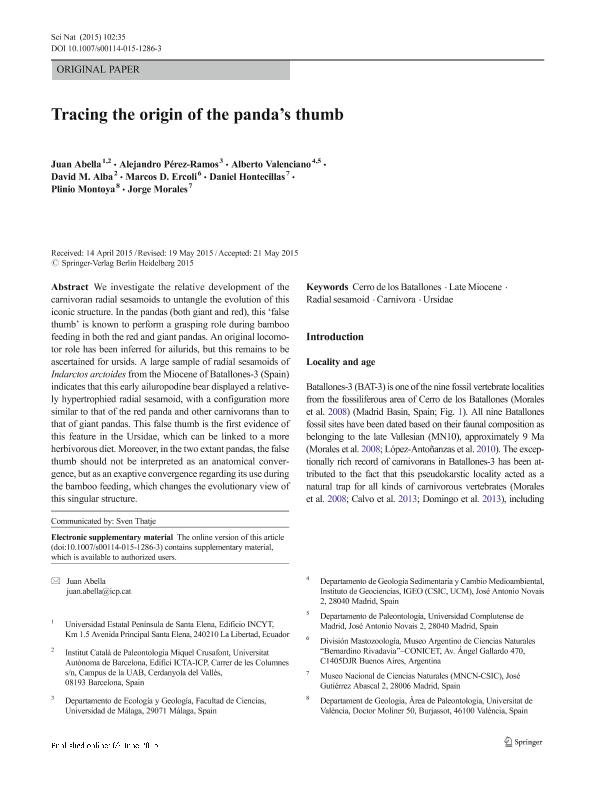Mostrar el registro sencillo del ítem
dc.contributor.author
Abella, Juan
dc.contributor.author
Pérez Ramos, Alejandro
dc.contributor.author
Valenciano, Alberto
dc.contributor.author
Alba, David M.
dc.contributor.author
Ercoli, Marcos Darío

dc.contributor.author
Hontecillas, Daniel
dc.contributor.author
Montoya, Plinio
dc.contributor.author
Morales, Jorge
dc.date.available
2018-04-10T20:26:26Z
dc.date.issued
2015-06
dc.identifier.citation
Abella, Juan; Pérez Ramos, Alejandro; Valenciano, Alberto; Alba, David M.; Ercoli, Marcos Darío; et al.; Tracing the origin of the panda's thumb; Springer; Naturwissenschaften; 102; 6-2015; 1-13
dc.identifier.issn
0028-1042
dc.identifier.uri
http://hdl.handle.net/11336/41623
dc.description.abstract
We investigate the relative development of the carnivoran radial sesamoids to untangle the evolution of this iconic structure. In the pandas (both giant and red), this ‘false thumb’ is known to perform a grasping role during bamboo feeding in both the red and giant pandas. An original locomotor role has been inferred for ailurids, but this remains to be ascertained for ursids. A large sample of radial sesamoids of Indarctos arctoides from the Miocene of Batallones-3 (Spain) indicates that this early ailuropodine bear displayed a relatively hypertrophied radial sesamoid, with a configuration more similar to that of the red panda and other carnivorans than to that of giant pandas. This false thumb is the first evidence of this feature in the Ursidae, which can be linked to a more herbivorous diet. Moreover, in the two extant pandas, the false thumb should not be interpreted as an anatomical convergence, but as an exaptive convergence regarding its use during the bamboo feeding, which changes the evolutionary view of this singular structure.
dc.format
application/pdf
dc.language.iso
eng
dc.publisher
Springer

dc.rights
info:eu-repo/semantics/openAccess
dc.rights.uri
https://creativecommons.org/licenses/by-nc-sa/2.5/ar/
dc.subject
Cerro de Los Batallones
dc.subject
Late Miocene
dc.subject
Radial Sesamoid
dc.subject
Carnivora
dc.subject
Ursidae
dc.subject.classification
Meteorología y Ciencias Atmosféricas

dc.subject.classification
Ciencias de la Tierra y relacionadas con el Medio Ambiente

dc.subject.classification
CIENCIAS NATURALES Y EXACTAS

dc.title
Tracing the origin of the panda's thumb
dc.type
info:eu-repo/semantics/article
dc.type
info:ar-repo/semantics/artículo
dc.type
info:eu-repo/semantics/publishedVersion
dc.date.updated
2018-04-10T14:19:26Z
dc.identifier.eissn
1432-1904
dc.journal.volume
102
dc.journal.pagination
1-13
dc.journal.pais
Alemania

dc.journal.ciudad
Berlin
dc.description.fil
Fil: Abella, Juan. Universidad Estatal Península de Santa Elena; Ecuador. Universitat Autònoma de Barcelona; España
dc.description.fil
Fil: Pérez Ramos, Alejandro. Universidad de Málaga; España
dc.description.fil
Fil: Valenciano, Alberto. Consejo Superior de Investigaciones Científicas. Instituto de Geociencias; España. Universidad Complutense de Madrid; España
dc.description.fil
Fil: Alba, David M.. Universitat Autònoma de Barcelona; España
dc.description.fil
Fil: Ercoli, Marcos Darío. Consejo Nacional de Investigaciones Científicas y Técnicas. Oficina de Coordinación Administrativa Parque Centenario. Museo Argentino de Ciencias Naturales ; Argentina
dc.description.fil
Fil: Hontecillas, Daniel. Museo Nacional de Ciencias Naturales; España
dc.description.fil
Fil: Montoya, Plinio. Universidad de Valencia; España
dc.description.fil
Fil: Morales, Jorge. Museo Nacional de Ciencias Naturales; España
dc.journal.title
Naturwissenschaften

dc.relation.alternativeid
info:eu-repo/semantics/altIdentifier/doi/http://dx.doi.org/10.1007/s00114-015-1286-3
dc.relation.alternativeid
info:eu-repo/semantics/altIdentifier/url/https://link.springer.com/article/10.1007%2Fs00114-015-1286-3
Archivos asociados
